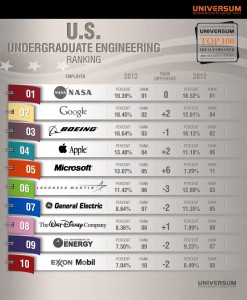Click Here to Return to the Introduction to this Post
1. Attract & Keep the Right People
Lawler claims that organizations must create a value proposition defining the type of workplace they want to be, so they can attract and retain the right people. The value proposition outlines who they are, what they want, and what they can offer people to achieve a high-performance culture. At NASA, we continue to have a strong brand. In fact, Universum’s (Global Research & Advisory Firm) annual survey of nearly 10,000 undergraduate engineering students found than almost one-fifth (19.4%) chose NASA—making us the #1 “most attractive” employer for engineering students!
2. Hire the Right People
Organizations must hire people who fit with their values, core competencies, and strategic goals. Lawler explains that people can rarely be forced to fit into an organization after they are hired. He notes that organizations should involve people who will work with the candidates in the interview process, providing realistic job previews where possible.
In our HR organization, we have an extensive day-long interview process—partly because we want to see candidates when they are tired and partly because we want to provide them as much information as they provide to us. As part of that process, we generally have the candidate go to lunch with early-career folks, who will provide a realistic preview of the job. We want to make sure our organization is a good match for them as much as we are assessing their match for our organization.
3. Develop People Right
Organizations must continuously train employees to do their jobs and offer them opportunities to grow. People enjoy opportunities to learn, develop, and experience new things. Creating a learning culture is an essential element of treating people right.
NASA has long supported workforce training and development. In fact, a few years ago, we re-branded our Mentoring Program as “Your Opportunity to Develop Another” (YODA), securing LucasFilms permission to use Star Wars images as part of our marketing efforts. Now, that’s Out of This World Leadership!
4. Design Work Right
Organizations must design work so that it is meaningful for people and provides them with feedback, responsibility, and autonomy. A great deal of research suggests that when jobs are designed to contain high levels of involvement and challenge, the result is high levels of intrinsic motivation & satisfaction. Management should make every effort to move decision-making power downward in the organization.
At NASA, much of our work is accomplished by teams. Designing effective work teams who are responsible for significant results is key to our success.
5. Establish the Right Goals
Organizations must develop and adhere to a specific organizational mission, with strategies, goals, and values that employees can understand, support, and believe in. Research shows that participation in setting goals increases people’s commitment to goals. A rally goal—a single metric or key accomplishment your organization is striving to reach—can be very powerful in motivating people to improve performance. Lawler points to NASA’s goal to land a man on the moon by the end of the 1960’s as a prime example.
One engineering organization at NASA recently used a town meeting process to refine its mission, vision, and value statements to further enhance employee engagement and line of sight for future objectives. I was able to see first-hand the excitement this different process generated.
6. Reward People Right
Organizations must devise and implement reward systems that reinforce their design, core values, and strategy.
NASA utilizes a variety of awards to recognize individual and team accomplishments. We recently started a peer recognition process that is accompanied by an “experience” award. Many of our employees aren’t able to tour different labs or facilities that the astronauts—or even the public for that matter—see, so this award gives them an opportunity to choose their experience. We’ve received great feedback from employees about this new approach.
7. Lead People Right
Organizations must hire and develop leaders who can create commitment, trust, success, and a motivating work environment. Lawler suggests that what employees want and need from their leaders is nicely summarized in a simple statement: they want a work environment in which they can reach their goals. He goes on to say that managers have the power to shape this environment through work structure, mission, goals, and rewards. Part of treating people right, he suggests, is that managers behave in ways that are respectful, fair, and ethical.
Lawler ends his book by saying, “When all is said and done, organizations are created by people to serve people. Their survival should and does depend on how well they serve people—they do not have a right to exist otherwise.”
Well said…and practicing these 7 principles of Treating People Right will mark you as an “Out of This World Leader”…

